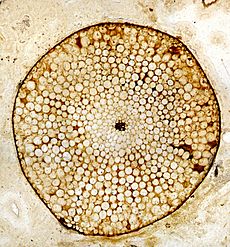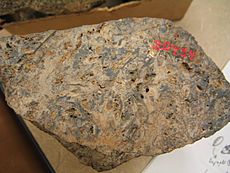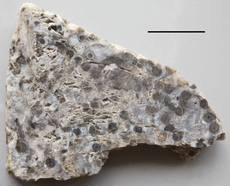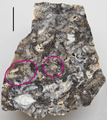Rhynie chert facts for kids

The Rhynie chert is an Lower Devonian sedimentary deposit, part of the Old Red Sandstone. It has extraordinary fossil details, and is a Lagerstätte.
The chert is exposed near the village of Rhynie, Aberdeenshire, Scotland. A second unit, the Windyfield chert, is located some 700 m away.
The Rhynie chert contains exceptionally preserved material covered by an overlying volcanic deposit. Most of the fossil bed has primitive plants (which had water-conducting cells and sporangia, but no true leaves), along with arthropods, lichens, algae and fungi.
Contents
Significance
Date
This fossil bed is remarkable for two reasons. First, the age of the site, formed about 410 million years ago. This places it at an early stage in the colonisation of land.
Quality
Second, these cherts are famous for their exceptional state of preservation, with individual cell walls easily visible in polished specimens. Stomata have been counted and lignin remnants detected in the plant material. The book lungs of some early spiders can be seen in cross-sections. Fungal hyphae can be seen entering plant material, acting as decomposers and mycorrhizal symbionts.
The oldest known insect (Rhyniognatha hirsti), which resembles the modern springtails, was found in the Rhynie chert, pushing dates for the origination of insects back to the Silurian period.
History of research
The chert was discovered by William Mackie while mapping the western margin of the Rhynie basin in 1910–1913.
Since 1980, the chert has been examined by the Münster group, and from 1987 by Aberdeen University. They showed the chert was indeed produced by a hot spring setting. Cores were drilled in 1988 and 1997.
Conditions of formation
The chert was formed when silica-rich water from volcanic springs rose and rapidly petrified the early terrestrial ecosystem in situ. Organisms are petrified that way by hot springs today, although that quality of preservation has not been found in recent deposits. Hot springs, with temperatures between 90 to 120 °C (194 to 248 °F), were active; the water had probably cooled to under 30 °C (86 °F) before it reached the fossilised organisms. The deposits are interbedded with sands, shales and tuffs, which speaks of local volcanic activity. Deposition was very rapid.
The texture of the silica formed is like that found today in freshwater streams at Yellowstone National Park. They are typically alkaline (pH 8.7) and tepid 20 to 28 °C (68 to 82 °F).
Living vegetation covered around 55% of the land area, with litter covering 30% and the remaining 15% of the ground being bare.
Images for kids
See also
 In Spanish: Rhynie Chert para niños
In Spanish: Rhynie Chert para niños




